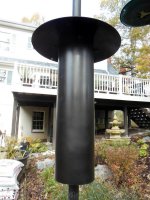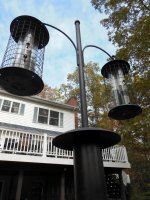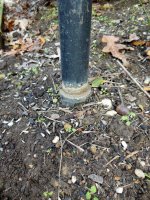If you're a song bird lover, you probably share a common experience: squirrels.
Squirrels are pigs. They're tree-bound rats with long trails. They aren't content to feast off of the abundance of nuts that the forest provides. They love sunflower seeds and as soon as they spot a bird feeder full of them, they converge and attack without mercy. They can purge a large bird feeder of seed within 24 hours. While I was once fortunate to witness one brave bird go into attack fighter mode and dive bomb one squirrel that was gorging himself and drop the offender to the ground, most tweeties are defenseless against the furry horde.
You've no doubt purchased several feeders which were advertised as squirrel-proof only to discover that they were anything but squirrel-proof. If you're like me, you subsequently resorted to your own designs. I've gone through at least a dozen only to learn that squirrels are both persistent and smart. I've had them chew through the wire that suspended the feeder so it crashed to the ground. I've even had them go into beaver mode and try to topple a 4x4 post that held the feeder after I put a piece of stove pipe around it to prevent them from climbing up. I've seen them easily scurry up a piece of 1-1/2" pipe I thought would be too small for them to climb.
So, finally after revision X, I have the ultimate design which I am all too happy to share with you. Voila:
It uses commonly available 1-1/2" cast iron pipe for strength and durability; 2 commonly available garden flower pot hooks to suspend the feeder; and a 6" PVC pipe and commercial squirrel blocker to prevent the little terds from climbing the pole. To date, not a single squirrel has defeated the design and made it to the feeders.
Materials:
-- One 10' section of 1-1/2" cast iron pipe from Lowes. Cut into one 2' section and one 8' section; threaded on both ends of the 8 footer and one end of the 2 footer. Lowes will cut and thread for you.
-- One threaded 1-1/2" coupler to join the 2 sections of pipe together.
-- One threaded 1-1/2" cast iron pipe cap to cap the top off for appearance and to keep moisture out.
-- 2 steel/iron flower pot hanger hooks available from most garden centers.
-- A short piece of 6" PVC pipe.
-- 4 3/8" x 3" galvanized bolts plus one nut each.
-- A squirrel baffle (the semi-spherical dome shown in the pic). Got mine from Lowes for $13
-- 60# bag of concrete.
-- Can or primer and finish spray paint.
-- 2 bird feeders of your choice. Don't waste money on so-called squirrel proof versions.
Theory of Operation:
-- Most importantly, the feed pole has to be located far enough from a tree or other structure as to prevent squirrels from jumping from there to the feeder pole.
-- Since they have no way to jump onto the feeder, they are going to try and climb up the pole. They will get as far as the 6" PVC pipe. The pipe is too big for them to climb around it. The smaller squirrels might make it inside the pipe, but they will get as far as the baffle on top of the PVC and be stopped dead in their tracks. The baffle alone may be sufficient. But since this is the ultimate feeder, I added the 6" PVC pipe.
-- Since the pole is made of cast iron, they're not going to be able to chew threw it and drop it to the ground (until such time as they learn how to use a hacksaw).
Construction:
-- Buy the components from your local hardware store. Note: you do not necessarily have to cut the 10' into 8' and 2' sections. I did so because I buried the 2' section, then used the female-female threaded coupler to attach the 8' section above ground. This was I can take the top section down for maintenance or repainting in the future. You could just bury the entire 10' section.
-- Find a local welding shop who can weld the arched flower pot hangers onto the side of the pipe near the top of the pipe as shown in the photo. Guy Brothers did mine for $20.
-- Lightly sand the pipe and fittings, 6" PVC pipe, arched flower pot hangers, and squirrel baffle. Prime with a quality primer; allow to dry and coat with several light coats of finish paint. You may also need to use a clean wrap with some mineral spirits or thinner to get the coat of oil off of the pipe before painting. Spending some time here and doing it right will result in a finish that will last for years. Wait 24-48 hours until the paint has hardened.
-- Find a spot for the pole and use a post-hole digger to dig a hole about 20" inches deep. You'll want the coupler a few inches above ground.
-- Find 2 or 3 old 3-4" bolts laying around in your shop and drill holes in the lower 2/3 of the 2' section of pipe to allow them to pass thru. I use this technique to ensure the pipe won't turn loose after it has been set in the concrete. The bolts sticking thru the pipe will act as anchors and ensure the pipe stays in place.
-- When you're ready to install the pipe in the ground, round up your tools to mix the concrete and a level so you can plumb the pipe. Join the 2' and 8' section of the pipe together using the threaded couple. You'll need 2 pipe wrenches (your paint finish will be marred a little in this step). I also coat the threads and the insides of the pipes near the fittings with grease to retard the rusting process.
-- Throw an inch or 2 of stones or gravel in the hole for drainage. Set the pipe in place and check plumb with the level. Have your helper shovel in some concrete as you recheck the plumb. Tamp down the concrete as you go. When the hole is filled, it should be stable enough to stand on its own until the concrete sets. Otherwise setup some supports to hold it.
-- Wait a day or more for the concrete to dry. Now you can install the squirrel blocker. Drill 4 holes 90-degrees apart about 2-3" down from the top of the 6" PVC. The holes should be one size smaller than the 4 galvanized bolts you purchased. This will allow you to thread the bolts into the plastic pipe. First put the nuts on the bolts, then thread the bolts into the 6" pipe. These 4 bolts will act to clamp the 6" PVC onto the cast iron pipe. Slide the 6" PVC over the top of the cast iron pipe. Set the top at about eye level. Tighten all 4 bolts a little at a time until the PVC is securely fasten. Then tighten the bolts tight against the PVC to keep them from moving in the future (see photo)
-- Now slide the squirrel baffle on so its sits on top of the PVC pipe. I had to use a metal file to make the hole in the baffle large enough to fit over the cast iron pipe.
-- Now you can screw your cast iron cap onto the top of the pole.
-- Hang your 2 bird feeders from the 2 hooks.
-- Enjoy your victory over the furry rats!
Squirrels are pigs. They're tree-bound rats with long trails. They aren't content to feast off of the abundance of nuts that the forest provides. They love sunflower seeds and as soon as they spot a bird feeder full of them, they converge and attack without mercy. They can purge a large bird feeder of seed within 24 hours. While I was once fortunate to witness one brave bird go into attack fighter mode and dive bomb one squirrel that was gorging himself and drop the offender to the ground, most tweeties are defenseless against the furry horde.
You've no doubt purchased several feeders which were advertised as squirrel-proof only to discover that they were anything but squirrel-proof. If you're like me, you subsequently resorted to your own designs. I've gone through at least a dozen only to learn that squirrels are both persistent and smart. I've had them chew through the wire that suspended the feeder so it crashed to the ground. I've even had them go into beaver mode and try to topple a 4x4 post that held the feeder after I put a piece of stove pipe around it to prevent them from climbing up. I've seen them easily scurry up a piece of 1-1/2" pipe I thought would be too small for them to climb.
So, finally after revision X, I have the ultimate design which I am all too happy to share with you. Voila:
It uses commonly available 1-1/2" cast iron pipe for strength and durability; 2 commonly available garden flower pot hooks to suspend the feeder; and a 6" PVC pipe and commercial squirrel blocker to prevent the little terds from climbing the pole. To date, not a single squirrel has defeated the design and made it to the feeders.
Materials:
-- One 10' section of 1-1/2" cast iron pipe from Lowes. Cut into one 2' section and one 8' section; threaded on both ends of the 8 footer and one end of the 2 footer. Lowes will cut and thread for you.
-- One threaded 1-1/2" coupler to join the 2 sections of pipe together.
-- One threaded 1-1/2" cast iron pipe cap to cap the top off for appearance and to keep moisture out.
-- 2 steel/iron flower pot hanger hooks available from most garden centers.
-- A short piece of 6" PVC pipe.
-- 4 3/8" x 3" galvanized bolts plus one nut each.
-- A squirrel baffle (the semi-spherical dome shown in the pic). Got mine from Lowes for $13
-- 60# bag of concrete.
-- Can or primer and finish spray paint.
-- 2 bird feeders of your choice. Don't waste money on so-called squirrel proof versions.
Theory of Operation:
-- Most importantly, the feed pole has to be located far enough from a tree or other structure as to prevent squirrels from jumping from there to the feeder pole.
-- Since they have no way to jump onto the feeder, they are going to try and climb up the pole. They will get as far as the 6" PVC pipe. The pipe is too big for them to climb around it. The smaller squirrels might make it inside the pipe, but they will get as far as the baffle on top of the PVC and be stopped dead in their tracks. The baffle alone may be sufficient. But since this is the ultimate feeder, I added the 6" PVC pipe.
-- Since the pole is made of cast iron, they're not going to be able to chew threw it and drop it to the ground (until such time as they learn how to use a hacksaw).
Construction:
-- Buy the components from your local hardware store. Note: you do not necessarily have to cut the 10' into 8' and 2' sections. I did so because I buried the 2' section, then used the female-female threaded coupler to attach the 8' section above ground. This was I can take the top section down for maintenance or repainting in the future. You could just bury the entire 10' section.
-- Find a local welding shop who can weld the arched flower pot hangers onto the side of the pipe near the top of the pipe as shown in the photo. Guy Brothers did mine for $20.
-- Lightly sand the pipe and fittings, 6" PVC pipe, arched flower pot hangers, and squirrel baffle. Prime with a quality primer; allow to dry and coat with several light coats of finish paint. You may also need to use a clean wrap with some mineral spirits or thinner to get the coat of oil off of the pipe before painting. Spending some time here and doing it right will result in a finish that will last for years. Wait 24-48 hours until the paint has hardened.
-- Find a spot for the pole and use a post-hole digger to dig a hole about 20" inches deep. You'll want the coupler a few inches above ground.
-- Find 2 or 3 old 3-4" bolts laying around in your shop and drill holes in the lower 2/3 of the 2' section of pipe to allow them to pass thru. I use this technique to ensure the pipe won't turn loose after it has been set in the concrete. The bolts sticking thru the pipe will act as anchors and ensure the pipe stays in place.
-- When you're ready to install the pipe in the ground, round up your tools to mix the concrete and a level so you can plumb the pipe. Join the 2' and 8' section of the pipe together using the threaded couple. You'll need 2 pipe wrenches (your paint finish will be marred a little in this step). I also coat the threads and the insides of the pipes near the fittings with grease to retard the rusting process.
-- Throw an inch or 2 of stones or gravel in the hole for drainage. Set the pipe in place and check plumb with the level. Have your helper shovel in some concrete as you recheck the plumb. Tamp down the concrete as you go. When the hole is filled, it should be stable enough to stand on its own until the concrete sets. Otherwise setup some supports to hold it.
-- Wait a day or more for the concrete to dry. Now you can install the squirrel blocker. Drill 4 holes 90-degrees apart about 2-3" down from the top of the 6" PVC. The holes should be one size smaller than the 4 galvanized bolts you purchased. This will allow you to thread the bolts into the plastic pipe. First put the nuts on the bolts, then thread the bolts into the 6" pipe. These 4 bolts will act to clamp the 6" PVC onto the cast iron pipe. Slide the 6" PVC over the top of the cast iron pipe. Set the top at about eye level. Tighten all 4 bolts a little at a time until the PVC is securely fasten. Then tighten the bolts tight against the PVC to keep them from moving in the future (see photo)
-- Now slide the squirrel baffle on so its sits on top of the PVC pipe. I had to use a metal file to make the hole in the baffle large enough to fit over the cast iron pipe.
-- Now you can screw your cast iron cap onto the top of the pole.
-- Hang your 2 bird feeders from the 2 hooks.
-- Enjoy your victory over the furry rats!








 I thought you'd be the one to find it.....
I thought you'd be the one to find it.....